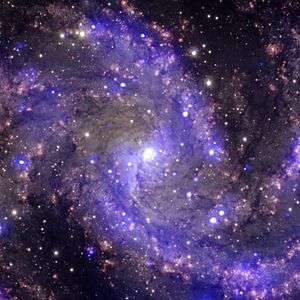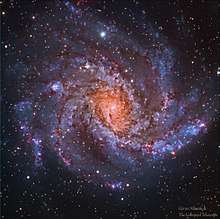NGC 6946
| NGC 6946 | |
|---|---|
 Spiral galaxy NGC 6946 | |
| Observation data (J2000 epoch) | |
| Constellation | Cepheus & Cygnus |
| Right ascension | 20h 34m 52.3s[1] |
| Declination | +60° 09′ 14″[1] |
| Redshift | 0.000160[1] |
| Helio radial velocity | 48 ± 2 km/s[1] |
| Distance |
22.5 ± 7.8 Mly (6.9 ± 2.4 Mpc)[2] |
| Apparent magnitude (V) | +9.6[1] |
| Characteristics | |
| Type | SAB(rs)cd[1] |
| Apparent size (V) | 11.5 x 9.8 arcmin[1] |
| Other designations | |
| UGC 11597, PGC 65001, Arp 29,[1] Caldwell 12 | |
NGC 6946 is a face-on intermediate spiral galaxy with a small bright nucleus, whose location in the sky straddles the boundary between the northern constellations of Cepheus and Cygnus. Its distance from Earth is about 22.5 million light-years or 6.8 megaparsecs[2], similar to the distance of M101 (NGC 5457) in the constellation Ursa Major.[3] Both were once considered to be part of the Local Group.[4] but are now known to be among the dozen bright spiral galaxies near the Milky Way but beyond the confines of the Local Group.[5] NGC 6946 lies within the Virgo Supercluster.[6]
Discovered by William Herschel on 9 September 1798, this well-studied galaxy has a diameter of approximately 40,000 light-years, about one-third of the Milky Way's size,[7] and it contains roughly half the number of stars as the Milky Way. The galaxy is heavily obscured by interstellar matter as it lies quite close to the galactic plane of the Milky Way. Due to its prodigious star formation it has been classified as an active starburst galaxy.[5]
Various unusual celestial objects have been observed within NGC 6964. This includes the so-called 'Red Ellipse' along one of the northern arms that looks like a super-bubble or very large supernova remnant, and which may have been formed by an open cluster containing massive stars. There are also two regions of unusual dark lanes of nebulosity, while within the spiral arms several regions appear devoid of stars and gaseous hydrogen, some spanning up to two kiloparsecs across.[5] A third peculiar object, discovered in 1967, is now known as "Hodge's Complex".[8] This was once thought to be a young supergiant cluster, but in 2017 it was conjectured to be an interacting dwarf galaxy superimposed on NGC 6964.[5]
Supernovae

Ten supernovae have been observed in NGC 6946 in the last century: SN 1917A, SN 1939C, SN 1948B, SN 1968D, SN 1969P, SN 1980K, SN 2002hh, SN 2004et,[9] SN 2008S, and SN 2017eaw.[10][11][12] For this reason NGC 6946 in 2005 was dubbed the Fireworks Galaxy,[13][14] a name becoming increasingly popular. NGC 6946 has an unusually high rate of supernovae production compared to our Milky Way galaxy, whose rate averages just one supernova event per century.[15] This is the more remarkable as our Galaxy comprises twice as many stars.
On 27 September 2004, the Type II supernova SN 2004et was observed at magnitude 15.2 and rose to a maximum visual magnitude of 12.7. Images taken several days earlier revealed no such star, indicating destruction of the star occurred on the 22 September. The progenitor of SN 2004et has been identified on earlier images –– only the seventh time that such an event was directly identified with its host star. The red supergiant progenitor had an initial mass of about 15M☉ in an interacting binary system shared with a blue supergiant.[9]
During 2009, a bright star within the galaxy NGC 6946 flared up over several months to become over one million times as bright as the Sun. Shortly thereafter it appeared to vanish. New observations with the Hubble Space Telescope strongly suggest that the star did not survive, although a faint trickle of infrared light emanates from where the star used to be. The remnant glow probably comes from debris falling onto a black hole that formed when the star died. This potential black hole-forming star is designated N6946-BH1.[16]
In X-rays, observations using the Chandra Space Telescope have revealed three of the oldest supernovae so far detected. The attached composite image also includes optical data from the Gemini Observatory in red, yellow, and cyan.[17]
References
- 1 2 3 4 5 6 7 8 "NASA/IPAC Extragalactic Database". Results for NGC 6946. Retrieved 2006-11-18.
- 1 2 "Distance Results for NGC 6946". NASA/IPAC Extragalactic Database. Retrieved 2010-06-18.
- ↑ Sandage, A.; Bedke, J. (1994). The Carnegie Atlas of Galaxies. Volume I. Carnegie Institution of Washington. Bibcode:1994cag..book.....S.
- ↑ "NGC 6946". SEDS. Retrieved 2017-11-20.
- 1 2 3 4 Efremov, Yu. N. (2016). "Unusual Objects in the Spiral Galaxy NGC 6946". 25 (4). Open Astronomy: 365–376. Bibcode:2016BaltA..25..369E. doi:10.1515/astro-2017-0255. Retrieved 20 November 2017.
- ↑ "Nearby Groups of Galaxies". ned.ipac.caltech.edu. Retrieved 2018-05-03.
- ↑ Nemiroff, R.; Bonnell, J., eds. (1 January 2011). "NGC 6964 : the Fireworks Galaxy". Astronomy Picture of the Day. NASA. Retrieved 2 November 2017.
- ↑ Hodge, P.W. (1967). "A Possible "Super-Supernova" Remnant in NGC 6946". 79 (466). Publications of the Astronomical Society of the Pacific: 466–470. Bibcode:1967PASP...79...29H. doi:10.1515/astro-2017-0255.
- 1 2 Li, W.; Van Dyk, S.D.; Filippenko, A.V; Cuillandre, J.C. (2005). "On the Progenitor of the Type II Supernova 2004et in NGC 6946". 117 (828). Publications of the Astronomical Society of the Pacific: 121–131. arXiv:astro-ph/0412487. Bibcode:2005PASP..117..121L. doi:10.1086/428278.
- ↑ http://www.astronomerstelegram.org/?read=10372
- ↑ http://www.astronomerstelegram.org/?read=10376
- ↑ "List of Supernovae". Harvard-Smithsonian Center for Astrophysics (IAU). Retrieved 2010-07-12.
- ↑ Michaud, Peter (1 January 2015). "Gemini Observatory Welcomes 2005 with Release of Galactic Fireworks Image". NASA. Retrieved 2017-10-15.
- ↑ Boen, Brooke (20 May 2015). "NGC 6946: The 'Fireworks Galaxy'". NASA. Retrieved 2016-12-08.
- ↑ "Gemini Observatory Welcomes 2005 with Release of Galactic Fireworks Image", Gemini Observatory, 1 January 2005, retrieved 2016-01-04
- ↑ Adams, S. M.; Kochanek, C. S.; Gerke, J. R.; Stanek, K. Z.; Dai, X. (2017). "The search for failed supernovae with the Large Binocular Telescope: conformation of a disappearing star". Monthly Notices of the Royal Astronomical Society. 468 (4): 4968–4981. arXiv:1609.01283v1. Bibcode:2017MNRAS.468.4968A. doi:10.1093/mnras/stx816.
- ↑ "Fireworks Galaxy NGC 6946". Retrieved 20 November 2017.
External links
- SEDS: Spiral Galaxy NGC 6946
- Pictures of NGC 6946
- Atlas of the Universe
- N6946-BH1 Giant Star Becomes A Black Hole Right Before Our Eyes!
- NGC 6946 on WikiSky: DSS2, SDSS, GALEX, IRAS, Hydrogen α, X-Ray, Astrophoto, Sky Map, Articles and images